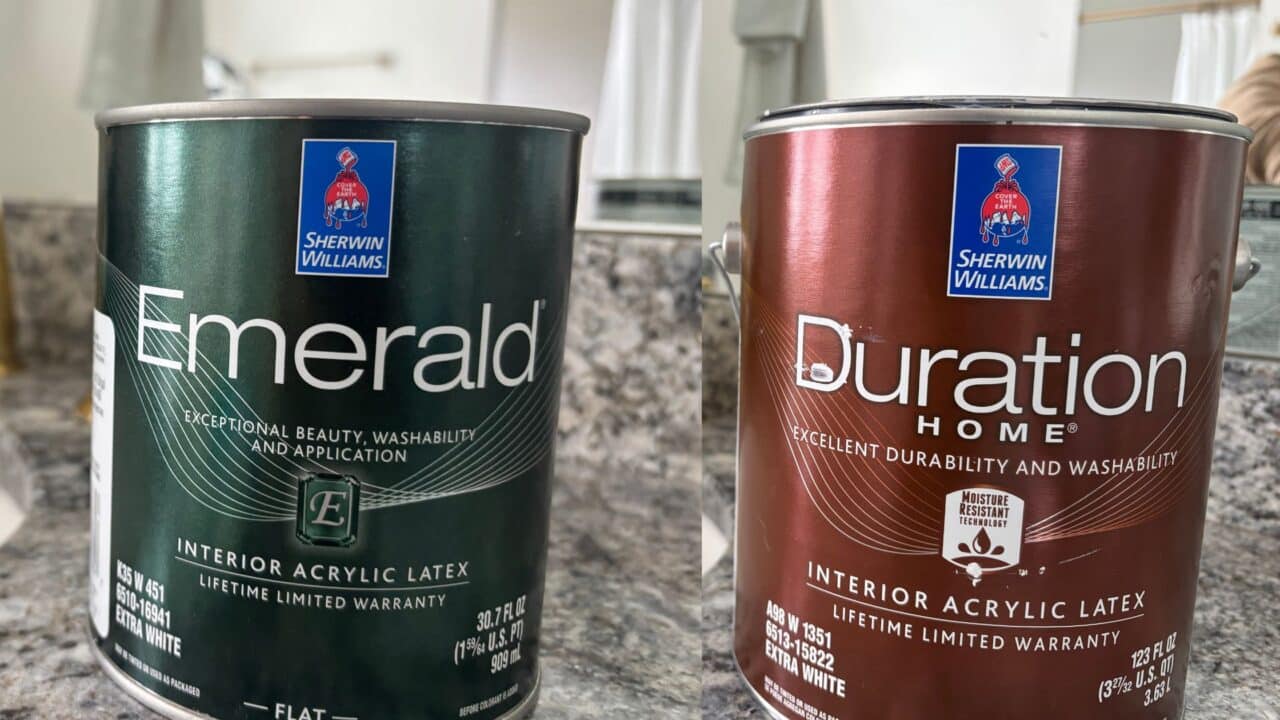Bathrooms deal with constant humidity, steam, and temperature swings — all enemies of regular wall paint.
To prevent peeling, mildew, and odors, choose a high-quality moisture-resistant paint, prep the surface properly, and maintain good airflow afterward.
In Cleveland’s mix of muggy summers and icy winters, paint choice matters just as much as prep and ventilation.
Top performers include Sherwin-Williams Emerald®, Duration Home®.
🚿 Why Bathroom Paint Matters More Than You Think
Bathrooms might look simple to paint, but they’re one of the harshest environments in the house.
Steam from showers, cleaning sprays, and fluctuating temperatures create micro-climates of trapped moisture that weaken ordinary paint.
When humidity seeps behind the paint film, it leads to:
-
Bubbling or peeling
-
Dark mildew spots
-
Musty odor or discoloration
-
Soft or “dripping” paint under condensation
Choosing the right formula keeps your bathroom fresher, longer — and saves you from early repainting costs.
🎨 1. Choose the Right Type of Paint
Go With Moisture-Resistant Formulas
Look for labels that mention “Bath,” “Spa,” “High Humidity,” or “Mildew-Resistant.”
Top options trusted by professional painters in Northeast Ohio:
-
Sherwin-Williams Emerald® Interior – Advanced mildew resistance with a smooth, washable finish for walls and ceilings.
-
Sherwin-Williams Duration Home® – Durable and scrubbable; great balance of performance and price.
-
Sherwin-Williams Bath Paint (Moisture-Resistant Technology) – Designed specifically for bathrooms and laundry rooms.
Pick the Right Sheen
Sheen is almost as critical as formula:
-
Satin or Semi-Gloss – Ideal for walls; repel moisture and wipe clean easily.
-
Flat or Matte – Best left to ceilings only. Too porous for steamy walls.
Pro Tip: In windowless bathrooms or basements, choose semi-gloss to get an extra layer of moisture defense.
Eco-Friendly and Low-Odor Options
If you’re sensitive to fumes or prefer greener materials, look for low-VOC or zero-VOC paints.
Sherwin-Williams Emerald® Designer Edition and Valspar Simplicity are both low-odor and compliant with strict air-quality standards — perfect for families repainting smaller, enclosed spaces.
🔧 2. Prep Like a Pro
Your paint will only perform as well as what’s underneath it.
-
Clean thoroughly. Remove soap film, dust, and mildew using water with vinegar or a TSP substitute.
-
Repair problem areas. Sand peeling spots and patch any drywall or plaster cracks.
-
Prime smartly.
-
Use a moisture-resistant primer if switching from flat to semi-gloss.
-
For older Cleveland plaster or glossy surfaces, apply Loxon® or Extreme Bond Primer for better adhesion.
-
-
Let everything dry completely. Painting over damp walls locks in moisture — and mildew.
3. Keep the Air Moving
Even premium paint can’t fight humidity forever without ventilation.
In Cleveland’s lake-effect winters, condensation builds quickly on cold surfaces.
Best practices:
-
Run your exhaust fan during and for at least 15 minutes after every shower.
-
Crack a window when possible.
-
Wipe condensation from mirrors and walls after bathing.
-
Keep towels and bathmats off painted walls.
🧼 4. Maintain for the Long Haul
A bathroom repaint can last 5–10 years with a little attention.
Monthly maintenance checklist:
-
Clean walls gently (avoid harsh bleach or abrasives).
-
Wash shower liners and curtains often — mildew spreads from these.
-
Re-caulk when cracks appear.
-
Spot-treat any gray dots or musty smells with diluted vinegar before repainting.
🚫 5. Avoid Common Mistakes
Top paint-ruining missteps homeowners make:
-
Skipping primer on raw drywall or stained walls.
-
Using ceiling paint on walls — it’s not moisture-rated.
-
Painting too soon after a shower — steam destroys adhesion.
-
Ignoring fan performance — you’ll be repainting again within a year.
Allow full drying between coats, maintain room temps above 50°F, and use two even coats for professional-grade results.
⏱️ 6. When to Repaint
Time for a new coat if you see:
-
Peeling or bubbling paint
-
Dull or yellowed surfaces
-
Sticky or soft texture after humidity
-
Persistent mildew that keeps returning
Lightly sand glossy areas, clean, and apply one new topcoat — bathrooms usually need this every 5–7 years, depending on ventilation.
💰 7. What It Costs
Homeowners often ask if special “bathroom paint” is worth the price.
Here’s the quick math:
| Type | Avg Price / Gallon | Coverage (per gal.) | Expected Lifespan |
|---|---|---|---|
| Standard Interior Latex | $55–75 | 350 sq ft | 3–5 yrs |
| Moisture-Resistant Acrylic (Duration Home®) | $85–95 | 350–400 sq ft | 5–8 yrs |
| Premium Mold-Resistant (Emerald® or Aura Bath & Spa) | $100–125 | 400 sq ft | 8–10 yrs |
When factoring in prep time and labor, higher-grade paint easily pays for itself through longer intervals between repaints.
8. Cleveland-Specific Tips
Older homes in the Heights, Euclid, or Lakewood often have plaster walls and limited ventilation.
To adapt:
-
Use bonding primer before paint on plaster.
-
Seal hairline cracks before painting — moisture can travel through them.
-
Basement bathrooms need dehumidifiers year-round; paint alone can’t stop mildew in damp spaces.
-
Winter is actually the best season to repaint bathrooms in Ohio — low outdoor humidity helps paint cure faster indoors.
❓ Frequently Asked Questions
Q: What’s the difference between mold-resistant and mildew-resistant paint?
Mildew resistance protects the surface of the paint; mold resistance includes additives that also deter growth beneath the paint film — useful in damp drywall or basements.
Q: Are there eco-friendly or low-VOC bathroom paints that still work?
Yes. Sherwin-Williams Emerald® Designer Edition and Valspar Simplicity are low-VOC yet highly durable against humidity.
Q: How much paint do I need for a small bathroom?
One gallon typically covers a full bathroom (two coats on walls). Larger master baths may need 1.5 – 2 gallons depending on layout. To know exactly, you need to measure the square footage of what needs covered. An average gallon of paint will get you 300-400 square feet of coverage per coat. So if you have say 350 square feet, you will want to get 2 gallons to do two coats.
Q: Can I use regular paint if my fan is strong?
It’s still risky. Moisture-resistant paint forms a tighter film and includes mildewcides that ventilation alone can’t replace.
Q: Do I have to replace drywall if mold is already behind it?
If the drywall feels soft, smells musty, or the mold covers more than 10 sq ft, replacement is safer than sealing it in.
Minor surface spots can be treated with vinegar or bleach solution and primed.
Q: What’s the best time of year to paint a bathroom in Cleveland?
Late fall through winter. Outdoor humidity is lowest, and you’re indoors anyway — the perfect time for painting projects.
Q: What’s the best paint for basement bathrooms?
Use a semi-gloss moisture-resistant acrylic like Duration Home® combined with an exhaust fan or portable dehumidifier.
Q: How long should I wait to shower after painting?
At least 48 hours before producing steam; longer if temps are below 60°F.
Q: What if I see bubbles or peeling soon after painting?
That usually means moisture was trapped. Let the area dry, sand lightly, spot-prime, and touch up with a new coat.
Cleveland Homeowners: Let’s Keep Your Bathroom Beautiful
A bathroom repaint is one of the simplest upgrades that makes a big impact.
At Colin Can Help, we use professional-grade Sherwin-Williams products and proper moisture-control prep to deliver smooth, durable finishes that withstand Northeast Ohio’s humidity swings.
Whether you need a quick touch-up or a full bathroom transformation, we’ll help you choose the right products and apply them the right way.

